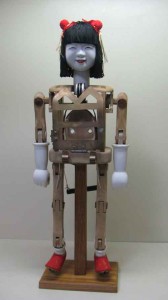Australian artist Kirsty Boyle is infusing the ancient Japanese tradition of mechanised puppetry with artificial intelligence for her girltron project. Her residency at the University of Zurich’s Artificial Intelligence Laboratory (AI Lab) with roboticist Dr Lijin Aryananda is bringing old and new traditions together in extraordinary ways, as she relates to Natasha Mitchell.
N: You’ve studied under Karakuri Ningyo master, Tamaya Shobei. What is Karakuri, and what especially drew you to the tradition?
Kirsty: ‘Karakuri’ means a mechanical device to tease, trick, or take a person by surprise. It implies hidden magic or an element of mystery. Central to the Karakuri philosophy is the concealment of technology, to evoke feelings and emotions, and a sense of hidden inner magic. As a teenager, I trained to be a puppeteer, then went on to study mechanical and electrical engineering. I continued my arts practice but have always worked with technology. In 2002, the opportunity arose to study with Tamaya Shobei.
N: Has this ancient, hand-built, mechanised tradition of Karakuri influenced Japan’s leadership in the robotics field?
Kirsty: The Karakuri tradition continues to influence the Japanese view of robots and it directly contributed to the industrial modernisation of Japan. Traditional Karakuri masters were scientists – the founders of Toshiba, Sony and Toyota all made Karakuri. They used it as a way of being expressive and creative with technology. Karakuri were, and still are, highly prized both in artistic and scientific senses.
Modern-day precision mechanics and various inventions have been developed and evolved as derivatives of these mechanical dolls. Examples include solar sails on satellites and bipedal walking humanoid robots.
N: How are you spending your time during your current residency in the AI Lab at the University of Zurich? What’s your girltron project, and what underpins it?
Kirsty: Broadly speaking, the girltron project considers robots as subjects of culture, with particular emphasis on how we experience and personalise our interactions with them. I’m combining AI with the Japanese Karakuri tradition to produce a hybrid robot.
Karakuri were actuated by puppeteers, or by wind-up mechanisms. Modern technology allows me to automate the traditional mechanical designs and employ AI.
Karakuri represented and embodied what was believed to be divine forces. They are each believed to be special and have their own spirit. I’m using AI to give girltron her own spirit and character. girltron will subtly possess the ability to perform several intelligent activities in parallel. She will also be reactive to viewers in various ways. I want to show that robots can be finely crafted art objects, versus something mass produced or an industrial tool. girltron has artistic merit, but also aims to produce solid scientific research outcomes and discoveries, and to promote the role of women in engineering and other non-traditional areas of science.
N: Some of your early girltron creations have involved blending baby-faced doll heads with robot bodies. You’ve called them ‘toy hacked robots’ – what’s the interplay you’re exploring there?
Kirsty: I had a lot of criticism regarding my involvement with the Karakuri tradition; people questioning why I felt the need to study a tradition that isn’t my native heritage. The earlier works were a way for me to explore the Western aesthetic of dolls and the way they have influenced me personally.
With the girltron robot I am now producing at the AI Lab, I have actually been encouraged by Master Shobei to base the design of the face on more traditional Japanese aesthetics. It’s a great relief to me that he’s so supportive and happy for me, in a sense, to now pursue my own style of Karakuri.
N: A residency in an institution involves learning a new language of expertise, but you’ve done a few international residencies – has spoken language presented some interesting hurdles in your collaborations?
Kirsty: Most people here speak at least three or four languages. At the lab we all speak English, but I’m the only native speaker. We have people from Switzerland (also Swiss-Italian, Swiss-Indian), France, Czechoslovakia, Romania, Japan, Indonesia, Columbia, Venezuela, Mexico … and backgrounds in computer science, mathematics, physics, biology, ethnology, neuroscience, psychology, philosophy, mechanical and electronic engineering… It is incredibly inspiring being in such surroundings. We are a very close community. Most days I work around 12 hours at the lab, I am so happy coming in to work. The hardest thing is that there is so much exchange that there are almost too many ideas … and not enough time in the day to realise everything.
Natasha Mitchell
Natasha Mitchell is a multi-award-winning radio broadcaster, science journalist, and host of All in the Mind with the Australian Broadcasting Corporation. In 2005–6, Natasha was awarded a Knight Science Journalism Fellowship, based at MIT and Harvard. She regularly hosts public events exploring the wonders and idiosyncrasies of the human condition, science and art.
Read More
 This work is licensed under a Creative Commons Attribution-NonCommercial-ShareAlike 2.5 Australia.
This work is licensed under a Creative Commons Attribution-NonCommercial-ShareAlike 2.5 Australia.







